Can Mold Spores Cause Chronic Migraines for Years
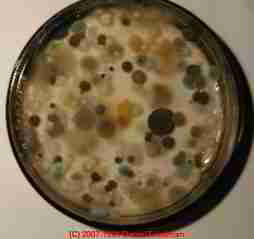 Mold Related Illness Symptoms & Complaints
Mold Related Illness Symptoms & Complaints
- POST a QUESTION or COMMENT about possible symptoms of mold related illness & health complaints
InspectAPedia tolerates no conflicts of interest. Nosotros have no relationship with advertisers, products, or services discussed at this website.
My House is Making Me Sick?
This Mold Related Illness Guide provides a broad alphabetize of reports of health complaints or symptoms, of Illnesses that are either caused, or aggravated by indoor mold exposure or alternatively, that were believed or suspected past individuals to have a role in their physical or mental health complaints.
Hither we provide descriptions and lists of ypes of mold reactions & list of Health complaints in moldy homes, lists of health complaints related to moisture or dampness and reports of those allergens & allergy illnesses in the domicile, types, causes, prevention. Health complaints by people sending mold samples to our laboratory. Photos of several Different-Appearing Mold-related Skin Rashes on People Not Suffering from Tinea
We too provide an ARTICLE INDEX for this topic, or yous can try the page top or bottom SEARCH BOX as a quick style to find information y'all need.
Broad classes of reactions to allergenic, pathogenic, or toxic mold, allergens, and other indoor gases or particles
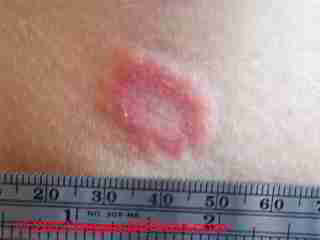 Four Categories of Mold-Related Illnesses, Symptoms, or Complaints
Four Categories of Mold-Related Illnesses, Symptoms, or Complaints
In agreement how exposure to mold might cause or contribute to illnesses it is useful to distinguish amidst the meanings of the words allergenic, pathogenic, and toxic effects that exposure to something might explicate.
Readers should not rely just on this document for medical diagnosis and instead should consult with their physician or with a specialist such as a medical toxicologist
- Allergenic - causing allergic Reactions - rhinitis, sinusitis, asthma, skin problems, other.
Quite a few of our clients reported non-Tinea (ringworm) skin rashes on exposure to high levels of mechanically disturbed molds, almost always during an amateur mold clean-upwardly job, often plain associated with Stachybotrys chartarum, and virtually immediately contacted on exposed (sometimes sweaty or moist) skin areas (cervix, face, head, hands, artillery) that were not protected during their mold cleanup project.
More examples of skin rashes that correlated in time of occurrence with significant indoor mold exposure are shown in this article
at DERMATITIS, SKIN RASHES,
and SKIN RASH FAQs.
- Pathogenic - Produces Infections, caused by pathogens such as leaner or viruses
- Mold Smell related Illnesses - headaches, vomiting, nausea, blocked noses, and asthmatic [MVOC'southward--DF]
- Toxic Illnesses - where mold is involved, may be produced by mycotoxins that are produced past some, not all, mold species. Notation that even for a "toxic" mold species, the actual level of toxicity can vary significantlty depending on growing conditions such every bit the growth substrate (what the mold is feeding-on), humidity, moisture, and other factors.
- Respiratory Illnesses - asthma, COPD, etc.
- Digestive Tract Illnesses - liver diseases: fibrosis and necrosis; vomiting, diarrhea, intestinal bleeding
- Reproductive Illnesses - infertility, variations in reproductive and hormonal cycle
- Highly Serious Illnesses - Cancer, Tuberculosi, Lupus, Sudden Infant Death Syndrome (SIDS), Chronic Fatigue Disorder (CFS), Fibromyalgi, Epstein-Barr, aspergillosis
Light-green links show where y'all are. © Copyright 2022 InspectApedia.com, All Rights Reserved.
List of Mold Related Illnesses & Health Complaints
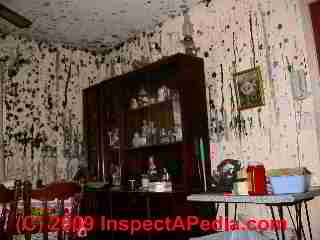 This list of mold related illness symptoms and complaints is arranged alphabetically and begins just below. This list is a combination specific, diagnosed medical illnesses and other anecdotally reported complaints associated with mold in buildings. Research to establish a house chain of causation between mold and other indoor particles (or other substances) and these complaints in many cases has not been completed.
This list of mold related illness symptoms and complaints is arranged alphabetically and begins just below. This list is a combination specific, diagnosed medical illnesses and other anecdotally reported complaints associated with mold in buildings. Research to establish a house chain of causation between mold and other indoor particles (or other substances) and these complaints in many cases has not been completed.
Nosotros capitalize names of known medical weather condition. While the following list may be of assistance to some readers researching this topic, it should by no means exist considered as scientifically authoritative nor consummate.
Some complaints are listed hither without any solid medical evidence regarding causation, if the complaints accept been expressed to us past people investigating mold-related disease or edifice mold contamination. Such data should be considered for research purposes and not medically authoritative.
We are interested in adding to this list as well as providing succinct symptom lists associated with medically-diagnosed mold related illnesses. Suggestions and criticism are invited.
Too see MOLD RELATED ILLNESS GUIDE
Alphabetical Index to Symptoms of Mold Related Illnesses, Medical & Anecdotal
A - B - C - D - E - F - Thousand - H - I - J - K - L - M - N - O - P - QR - South - T - U - V - WXYZ
Watch Out: this certificate is a mold-related symptom or complaint listing, non a medical certificate.
This mold-disease-symptoms & complaints list does, nonetheless, collect both substantiated mold-related-illness complaints and a broad sampling of the nature and range of other complaints from people who believe or fear that mold or similar exposure has been a factor in their physical or mental health, a general reference for individuals or physicians interested in reading the nature and range of these complaints that may or may not actually be edifice or environs-related.
Can Mold Make You Sick? We alive in a ocean of mold, and other stuff in the air we exhale, on cushions nosotros sit on, clothes we wear, pools we swim-in, so on. Most mold is not pain anyone, and some of it makes us well when nosotros're ill(Penicillium notatum, for example). Fear of mold (mycophobia) is unjustified and in our opinion, more than a result of media hype, ENVIRO-SCARE, and gouging consumers.
A salubrious person walking through a room of moldy air is not probable to die. On the other mitt, there is a wealth of less rigorous empirical data matching occupant complaints with indoor mold and allergens.
Finally, for certain people, mold can be a serious trouble if it'southward at high levels indoors. Information technology'southward probably an overstatement by some authorities who assert that "... there are no proven links betwixt mold and illness" - nosotros refer readers to some of our lab's references for descriptions of illness-related molds, some of which are found in buildings.
See this split up
article MOLD RELATED ILLNESS GUIDE,
an Index to detailed articles aid in identifying illnesses that may be related to toxic or allergenic mold exposure. This is an atlas of mold related illness symptoms and complaints & of mold toxicity.
Readers needing a medical diagnosis of mold related illness should consult with their dr. or with a specialist such as a medical toxicologist. If you lot need a specialist consult your family doc and besides
see MOLD DOCTORS - ENVIRONMENTAL MEDICINE
Alphabetic Index to Common Mold-related Illness Symptoms & Complaints
A
- Intestinal pain - also see Crohn'due south disease under C or inflammatory bowel disease under I
- Abnormal pap smears
- Acrid reflux
- Acne
- Allergy symptoms (broad variety of), mild to astringent and from transitory to chronic - Ref: Middleton and assoc.
- Allergic Bronchiopulmonary Aspergillosis (ABPA) - worsening of underlying asthma or cystic fibrosis,
cough upward blood, weight loss, fever, wheezing, muicous plugs produced past coughing - uncommon, occurs in persons with asthma and those with cystic fibrosis (CF) - Allergic Rhinitis and asthma are associated with responses mediated past immunoglobulin East (IgE)
- "Damp house linked to kids' risk of nasal allergies", New York Times, 1 Aug 2010
- Altered immunity
- Anaphylaxis
- Apnea, sleep
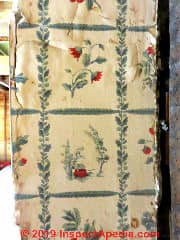
- Arsenic poisoning related to mold growth on antique wallpaper: Some antique light-green wallpaper pigments interact with some molds to release poisonous arsenic.
See details almost arsenic related disease found
at ARSENIC HAZARDS at BUILDINGS & EXPOSURE HAZARDS for more about arsenic poisoning from this arsenic element in its gaseous course. A discussion of arsenic poisoning from Arsine Gas Exposure Hazards - Arsenic Hydride
More than details are
at ARSENIC GREEN in WALLPAPER - greenish-pigmented wallpaper using arsenic green combined with mold growth releases toxic gases,discussed in our index to mold growths on building surfaces
establish in our MOLD GROWTH on SURFACES, Table OF
Also see more than abour arsenic poisoning institute
at ARSENIC in Water
- Aspergilloma (fungal growth in lung), cough, coughing, fever, weight loss. Uncommon. May be asymptomatic only evidence up in a lung X-ray in some patients who have a pre-existing lung cavity (due east.grand. due to T.B.), occurs in patients suffering HIV + pneumonia; coughing upward blood is a serious and life thereatening status;
- Aspergillosis, Chronic necrotizing Aspergillus pneumonia, or Chronic necrotizing pulmonary aspergillosis (CNPA) occurs in patients with an underlying disease such equally COPD or alcoholism, symptoms include subacute pneu7monia, fever, cough, nighttime sweats, weight loss.
- Aspergillosis, Invasive, occurs in patients who suffer from immunosuppression or prolonged neutropenia, leukemia, and others; symptoms include fever, cough, chest pain, difficulty animate (dyspena), rapid breathing (tachypnea).
See ASPERGILLOSIS for details about the above Aspergillus-related illnesses.
- Asthma and asthmatic signs
- Asthma, adult onset
- Asthma, sudden onset, any age
- Asthma, increased symptoms or renewal of previously diminished symptoms
- Asthma due to fungal allergens: chest tightness, wheezing, cough, dyspnea. Worsens w/ exposure. Cx typically occur within 1 hour of exposure
2019/04/09 The New York Times reported a possible relationship between abnormally high levels of presence of the fungus Malassezia in the intestines and both the presence of and perchance improved handling for inflammatory bowel disease including Chron's affliction. - Rogers, Lakeigh, "You're Covered in Fungi. How's Your Health? Researchers explore potential contributors to inflammatory bowel diseases." The New York Times, ix April 2019, p. D-6.
The article also cites possible connections between abnormally high levels of presence of the fungus Malassezia in the gut and asthma and also a possible association with prostate cancer.
B
- residuum, loss of
- float and kidney pain
- Blastomycosis : "blasto" most-common in the U.Southward. in the Ohio and Mississippi river valleys, as far north as Minnesota. Can infect humans, causing both lung and skin infections infections ranging from asymptomatic to very serious
Saccente, Michael, and Gail L. Wood. "Clinical and laboratory update on blastomycosis." Clinical Microbiology Reviews 23, no. ii (2010): 367-381.
Summary: Blastomycosis is owned in regions of North America that border the Cracking Lakes and the St. Lawrence River, too as in the Mississippi River and Ohio River basins.
Men are affected more than often than women and children because men are more likely to participate in activities that put them at risk for exposure to Blastomyces dermatitidis. Human infection occurs when soil containing microfoci of mycelia is disturbed and airborne conidia are inhaled.
If natural defenses in the alveoli fail to comprise the infection, lymphohematogenous dissemination ensues. Normal host responses generate a characteristic pyogranulomatous reaction.
The near common sites of clinical illness are the lung and peel; osseous, genitourinary, and central nervous arrangement manifestations follow in decreasing order of frequency.
Blastomycosis is ane of the great mimickers in medicine; verrucous cutaneous blastomycosis resembles malignancy, and mass-like lung opacities due to B. dermatitidis often are confused with cancer. Blastomycosis may be clinically duplicate from tuberculosis.
Diagnosis is based on culture and direct visualization of round, multinucleated yeast forms that produce daughter cells from a unmarried broad-based bud. Although a long course of amphotericin B is usually curative, itraconazole is also highly effective and is the mainstay of therapy for most patients with blastomycosis.
- haemorrhage lungs
- blood pressure irregularities
- trunk aches and muscle pains
- Boils and similar sores on skin, especially neck, simply anywhere, of varying size and surface texture (smooth, scaly) especially following disturbance of moldy materials (Southward. chartarum) (photos on file) - see Blastomycosis and Coccidioidmycosis
See also DERMATITIS
- Breathing difficulties, - see Blastomycosis and Coccidioidmycosis
- Bronchopulmonary aspergillosis / allergic bronchopulmonary aspergillosis: inflammatory disease acquired by immunologic response Aspergillus sp., usually A. fumigatus, growing in bronchi of asthmatics reported in immunocompromised patients and patients with chronic obstructive pulmonary disease (COPD) and has been linked to building-related illness (BRI)
See ASPERGILLOSIS
- bruising easily
- called-for oral fissure
- burning optics
- burning throat
- burning lungs
C
- Cancer - various, including prostate cancer
2019/04/09 The New York Times Rogers, Lakeigh, "You're Covered in Fungi. How's Your Health? Researchers explore potential contributors to inflammatory bowel diseases." The New York Times, ix April 2019, p. D-half-dozen.
The article cites possible connections between abnormally high levels of presence of the fungus Malassezia in the gut and a possible association with prostate cancer.
- Candida, systemic
Systemic candidiasis includes a spectrum of yeast infections caused by dissimilar species (types) of Candida.[1] It is a serious infection that can affect the claret, centre, brain, eyes, bones, or other parts of the body.
Although there are over 200 species of Candida, five different species of Candida cause xc% of systemic candidiasis.
The near common form of this invasive yeast infection is when Candida enters the bloodstream (candidemia). Signs of candidemia include fever and chills that do non ameliorate with antibiotics. Symptoms of other types of systemic candidiasis depend on the organ or system which is infected.
Systemic candidiasis is the most common fungal infection amid hosptilized people in high-income countries, including the United States. Diagnosis can be difficult, especially when the Candida is not found in the bloodstream.
Treatment commonly includes consists of oral or intravenous (IV) antifungal medications
Common symptoms of candidemia (Candida infection of the bloodstream) include fever and chills that exercise not improve with antibiotics. Candidemia can cause septic stupor and therefore may include symptoms such equally depression blood pressure, fast heart charge per unit, and rapid breathing.
Systemic candidiasis may as well affect other parts of the body such equally the central nervous system (brain and spinal string), belly, heart, kidneys, liver, bones, muscles, joints, spleen, and/or eyes.
Candidemia may be present, but non in all cases. Signs and symptoms depend on the organ or system infected.
For example, when Candida infects the eye, symptoms may include blurred vision with photophobia (the middle is overly senstive to light), whereas symptoms of candida endocarditis (Candida infection of the inner lining of the heart) may include fever, shortness of breath, fluid buildup in the arms or legs, tiny red spots on the peel, and weight loss.
Since many people who develop systemic candidiasis are already sick, it can be difficult to know which symptoms are from Candida infection and which symptoms are from complications of other medical conditions.
- NIH, "Systemic candidiasis", retrieved 2017/x/16, original source: https://rarediseases.info.nih.gov/diseases/1076/systemic-candidiasisAlso see: Chronic Candidiasis FAQ - Dr. Fungus: doctorfungus.org/mycoses/human being/candida/Chronic_Candidiasis.htm
- Primal nervous system disorders (CNS)
- Chest pain associated with excessive cough
- Chills
- Choking
- Cholesterol or triglycerides unusual variations
- Chronic fatigue syndrome (CFS)
Myalgic encephalomyelitis/chronic fatigue syndrome (ME/CFS), sometimes referred to as myalgic encephalomyelitis (ME) or chronic fatigue syndrome (CFS), is a debilitating disease that lacks a universally accustomed case definition, cause, diagnosis, or treatment.
According to the CDC (link is external), more than one million Americans have CFS. At least 1-quarter of individuals with ME/CFS are bedbound or housebound at some point in the illness and almost never regain their pre-disease level of operation.
ME/CFS strikes people of all ages and racial, ethnic, and socioeconomic groups, and is diagnosed two to 4 times more oft in women.
The disease is characterized by at to the lowest degree six months of incapacitating fatigue experienced as profound exhaustion and extremely poor stamina, and issues with concentration and brusque-term memory.
It is sometimes preceded by influenza-like symptoms followed by hurting in the joints and muscles, unrefreshing sleep, tender lymph nodes, sore throat, and headache. A distinctive characteristic of the illness is post-exertion malaise, which is a worsening of symptoms following concrete or mental exertion occurring inside 12-48 hours of the exertion and requiring an extended recovery period.
Although the cause of ME/CFS remains unknown, symptoms may be triggered past an infection.
- NIH, Near ME/CFS, retrieved 2017/x/16, original source https://world wide web.nih.gov/mecfs/about-mecfs - Chronic sinus infections
- Chron's Disease, inflammatory bowel disease -
2019/04/09 The New York Times reported a possible relationship betwixt abnormally high levels of presence of the fungus Malassezia in the intestines and both the presence of and perchance improved treatment for inflammatory bowel disease including Chron's disease. - Rogers, Lakeigh, "You're Covered in Fungi. How's Your Health? Researchers explore potential contributors to inflammatory bowel diseases." The New York Times, nine April 2019, p. D-six.
- Coated tongue
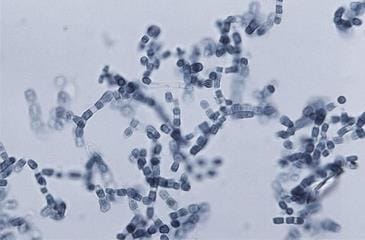
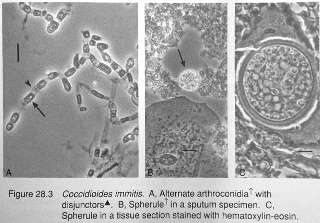
- Coccidioidomycosis - "cocci", most-common in Southwestern U.S. to California, West Texas to SOCAL, soil fungi infecting animals, tin infect humans, causing both lung and skin infections ranging from asymptomatic to very serious
Symptoms: Valley Fever: cough, fever, fatigue, chest pain. History of travel to areas where the coccidioides soil mucus is plant: southwestern United States, areas within Mexico and Due south America, also in south-primal Washington.
Excerpt from U.Due south. CDC:
Valley fever, also called coccidioidomycosis, is an infection caused past the mucus Coccidioides. The mucus is known to live in the soil in the southwestern United States and parts of United mexican states and Central and South America. The fungus was likewise recently found in s-central Washington.People tin can become Valley fever past breathing in the microscopic fungal spores from the air, although most people who breathe in the spores don't get sick. Usually, people who get sick with Valley fever volition go meliorate on their own within weeks to months, but some people will need antifungal medication.
Certain groups of people are at higher risk for becoming severely sick.
It'due south hard to prevent exposure to Coccidioides in areas where it'due south common in the surroundings, but people who are at higher run a risk for astringent Valley fever should try to avoid breathing in large amounts of dust if they're in these areas.
- retrieved 2016/08/18, original source: Valley Fever (Coccidiomycosis), U.S. CDC Centers for Disease Control & Prevention, Websitte: http://www.cdc.gov/fungal/diseases/coccidioidomycosis/ - Colds, recurrent
- Constipation
- Cough, dry hacking
- Cough up blood
- Cryptococcosis :
Cryptococcosis is a fungal infection that typically affects people with HIV, cancer, or other weather condition that weaken the torso'due south immune system.
The infection tin progress to pneumonia and meningitis, which may crusade serious symptoms of lung, brain, and spinal string disease, such every bit headaches, fever, cough, shortness of breath, confusion, and weakness.
People who recover from cryptococcal meningitis oftentimes need long-term handling with medication to prevent the infection from coming back.
- NIH, retrieved 2017/10/16, original source: https://www.niaid.nih.gov/clinical-trials/cryptococcosis-study
D
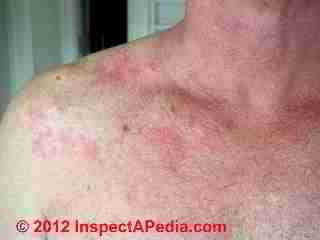
- dandruff resistant to usual treatments
- dark urine
- expiry in extreme cases (humans, other animals)
- Depression
- Dermatitis: red, itchy skin, pare rashes.
The mold-related skin rashes shown at the top of this page, at left, and beneath in at SKIN RASHES and our Peel RASH FAQs section illustrate patterns of skin rash suffered by some of our clients that appeared to be mold-related, usually following all-encompassing mold-exposure or exposure of someone who was highly allergic to molds.
Meet too see Blastomycosis and Coccidioidmycosis
- diarrhea
- difficulty concentrating
- difficulty in swallowing
- dirt-similar taste in oral fissure
- Disorientation: several clients take reported disorientation, memory loss, linguistic communication difficulties, and mood disorders that appeared to correlate with exposure to sure molds or MVOCs in their indoor surround.
- Dizziness
Eastward
- endometriosis
- Eye infections, (beware of undiagnosed fungal heart infections), loss of vision
- eye irritation
F
- face flushing intermittent
- facial movements, unexplained twitching
- farmers' lung disease
- fevers
- fibrous discharge from the olfactory organ, nasal fibers, mucosa - (Encounter Morgellon's syndrome or Morgellon'due south disease below)
- Fibromyalgia - numerous websites and articles discuss possible connections between mold exposure and
Fibromyalgia - including these:http://www.mold-survivor.com/fibromyalgia.html
http://www.swarthmore.edu/NatSci/SigmaXi/docs/PosterSummaries2003/zagory-
jessica.pdf#search=%22Fibromyalgia%20mold%20%22 - Swarthmore study
http://www.personalconsult.com/cgi-bin/htsearch - free clinical searchwe have also corresponded with people who study suffering from Fibromyalgia and significant mold exposures, though the identification of genera/species and level of exposure were lacking.
- Flu-like symptoms:
Alert: flu-like symptoms tin can be a sign of potentially fatal carbon monoxide poisoning! Immediate help may exist required. - Food allergies
- frequent bloody noses
- frequent infections
- Fungal infections, systemic such as Histoplasmosis, and Coccidioidomycosidue south, and Cryptococcosis, responding to contaminated bird droppings or structure dusts
Thou
- Glucan sensitivity: Glucans are glucose polymers that are components of well-nigh fungal cell walls, and exposure to airborne 13-beta-D-glucan has been known to crusade irritation symptoms due to airway inflammation (7). Notwithstanding, these irritant effects are transient and self-limiting
H
- hair loss
- headaches
- heart attack
- hemorrhagic pneumonitis
- Extrinsic Allergic Alveolitis - (Hypersensitivity Pneumonitis) -
- heartburn
- Histoplasmosis - respiratory illness from airborne spores of Histoplasma capsulatum
Histoplasmosis is a disease caused when airborne spores of the fungus Histoplasma capsulatum are inhaled into the lungs, the primary infection site.This microscopic fungus, which is institute throughout the world in river valleys and soil where bird or bat debris accrue, is released into the air when soil is disturbed by plowing fields, sweeping craven coops, or excavation holes.
Histoplasmosis is frequently and so mild that it produces no apparent symptoms. Any symptoms that might occur are oftentimes similar to those from a mutual cold.
In fact, if you had histoplasmosis symptoms, you might dismiss them as those from a cold or flu, since the trunk's allowed system ordinarily overcomes the infection in a few days without handling.
However, histoplasmosis, even mild cases, can afterward cause a serious eye disease chosen ocular histoplasmosis syndrome (OHS), a leading cause of vision loss in Americans ages 20 to 40.
- Source: NIH, Facts About Histoplasmosis, retrieved 2017/10/16, original source https://nei.nih.gov/health/histoplasmosis/histoplasmosisQuestion: is histoplasmosis grown or spread in sewage?
Can y'all tell me if it would be possible for histoplasma to grow in homo waste? My daughter has been diagnosed with histoplasmosis and the rest of the family unit is pending exam results. We have all had repeated astringent respiratory symptoms including pneumonia and bronchitis.
My daughter has adult asthma and mine has worsened. Several months ago, our main sewer line backed up and flooded a heat vent in the flooring. My house is on a physical slab so cleaning the air duct was not an option, and my landlord has refused to assistance. I'm only curious if this fungus could have grown there, and we became infected by turning on the heat for the first time in September and releasing spores into the air.
I am a unmarried female parent who is now out of work due to my daughter's hospitalization and treatment for the histoplasmosis. I have looked into testing companies, but I but cannot afford information technology. Any advice or assistance yous could provide with testing would be very much appreciated. 2018/11/02 past privatge e-mail
Answer:
Spotter out: the about of import stride for you to accept with your girl's illness is to be guided past advice from her doctors.
I institute ane research commodity (Patterson 1981) that related lung affliction and fungi to sewage contamination indoors, focused on Cephalosporium.
The histoplasmosis fungus is found throughout the globe and grows in soil that has been enriched with bat or bird droppings or in bat droppings themselves. For instance, the mucus is common around quondam chicken houses, in caves and other areas harboring bats, and around starling and blackbird roosts.
The fungus produces spores that can get airborne if the soil is disturbed. Inhalation of these spores may cause infection. -
IDPH, Illinois department of health IDPH Chicago Headquarters Offices 122 S. Michigan Avenue, 7th and 20th Floors Chicago, IL 60603 312-814-2793 Retrieved 2018/11/x, original source: http://dph.illinois.gov/topics-services/diseases-and-conditions/diseases-a-z-list/histoplasmosisHISTOPLASMOSIS FACT Canvas [PDF] Op. Cit. [Notation that "sewage" every bit a pertinent vector for histoplasmosis-related illness is non mentioned in this article]
However there are other respiratory illnesses that tin be caused past, aggravated-past, or spread by sewage contamination in or effectually buildings, including the spread of harmful fungi or spores. Some research examples:
Cooke, William Span, and Paul Kabler. "ISOLATION OF POTENTIALLY PATHOGENIC FUNGI FROM POLLUTED Water AND SEWAGE." [PDF] Public Wellness Reports seventy, no. 7 (1955): 689. -total text PDF is also available at https://world wide web.ncbi.nlm.nih.gov/pmc/articles/PMC2024593/pdf/pubhealthreporig00163-0077.pdf
Patterson, Roy, Jordan N. Fink, Wayne B. Miles, John Eastward. Basich, Donald B. Schleuter, David Thou. Tinkelman, and Mary Roberts. "Hypersensitivity lung disease presumptively due to Cephalosporium in homes contaminated past sewage flooding or by himidifier water." Journal of Allergy and Clinical Immunology 68, no. 2 (1981): 128-132.
Abstruse:
Ii cases of hypersensitivity lung disease apparently caused by habitation surround contamination with Cephalosporium have been identified. In ane case repeated flooding of the home with sewer h2o appeared to be important in maintaining an environment contaminated with Cephalosporium and in the other case a contaminated humidfier appeared to be the source.Both patients had chronic respiratory symptoms remitting during absence from the home, and both presented problems in diagnosis. In both cases cultures of the habitation environment or humidifier and serum antibody studies indicated Cephalosporium as the antigenic source responsible for the airway disease.
An inhalation claiming in one example was positive, adding further evidence for Cephalosporium as the antigenic source and etiologic agent. In both cases consummate remission followed moving from the home. Cephalosporium is reported as an credible antigenic source for home contamination resulting in significant chronic pulmonary morbidity.
Also come across this article in PDF grade CLEANING & DISINFECTING BIRD, BAT, or RODENT Debris [PDF] https://inspectapedia.com/structure/Cleaning-Disinfectant-Bird-Bat-Rodent-Droppings-Contec-Sporicidin.pdf
- Hives
- hypersensitivity to airborne allergens or house dust
- hypersensitivity to mold
- Hypersensitivity Pneumonitis - (Extrinsic Allergic Alveolitis) - tightness of chest, difficulty breathing, coughing, fever, muscle aches, reactions occur 6-8 hrs after exposure. - Uncommon
Hypersensitivity pneumonitis, associated with T-prison cell responses and responses mediated by immunoglobulin Thousand (IgG). hypersensitivity pneumonitis is characterized by recurrent symptoms of fever, coughing, and breast tightness and the presence of pulmonary infiltrates on a chest radiograph. Chronic hypersensitivity pneumonitis features progressive dyspnea, fatigue, interstitial pneumonitis, and pulmonary fibrosis (Farmer'due south lung)
Hypersensitivity pneumonitis is a rare immune system disorder that affects the lungs. Information technology occurs in some people after they exhale in certain substances they encounter in the environment. These substances trigger their immune systems, causing short- or long-term inflammation, especially in a role of the lungs chosen the interstitium.This inflammation makes it harder for the lungs to function properly and may fifty-fifty permanently damage the lungs. If diagnosed, some types of hypersensitivity pneumonitis are treatable past avoiding exposure to the environmental substances or with medicines such as corticosteroids that reduce inflammation.
If the condition goes untreated or is non well controlled over fourth dimension, the chronic inflammation can cause irreversible scarring of the lungs that may severely impair their ability to function.
- NIH, Hypersensitivity Pneumonitis, Also known as extrinsic allergic alveolitis, bird fancier's lung, farmer'due south lung, hot tub lung, and humidifier lung. Retrieved 2017/10/16, original source: https://www.nhlbi.nih.gov/health/health-topics/topics/hp
I
- Immune system deterioration, decreased resistance
- indigestion
- infertility
- Inflammatory bowel disease: Also encounter Chron'south illness.
2019/04/09 The New York Times reported a possible human relationship between abnormally high levels of presence of the mucus Malassezia in the intestines and both the presence of and possibly improved treatment for inflammatory bowel disease including Chron'southward disease. - Rogers, Lakeigh, "You're Covered in Fungi. How's Your Wellness? Researchers explore potential contributors to inflammatory bowel diseases." The New York Times, ix April 2019, p. D-6.
- Invasive pulmonary aspergillosis - pneumonia, fever, bone pain, chills - occurs in immunocompromised patients - uncommon. Run across ASPERGILLOSIS
- irritation: aggravated existing allergic rhinitis or asthma
- irritability
- irritable bowel syndrome
- itching skin, heart, olfactory organ, mouth
For skin-related itch and fiber complaints come across your medico. In addition to consulting your md who may in turn decide to refer you lot to a dermatologist, yous might too benefit from reviewing the ITCHING & SCRATCHING RESEARCH found in our article concerning MORGELLONS SYNDROME.
Too encounter itching related to FIBERGLASS HAZARDS.
J
- judgment, loss of power to think clearly and make decisions
K
- kidney hurting and failure
L
- learning difficulties
- leaky gut syndrome
- liver pain
- long lasting influenza-like symptoms
1000
- Memory loss
- Menopause, unanticipated onset
- Metallic taste in mouth
- Migraine headaches
- Mood swings, sudden
- Morgellon'south syndrome or Morgellon'south affliction: symptoms including fibers in nasal secretions, perceived fibers in skin and scalp particles or scrapings - pare lesions.
Co-ordinate to the Mayo Clinic Staff,
Morgellons affliction is a mysterious skin disorder characterized by disfiguring sores and crawling sensations on and under the skin.
Although Morgellons disease isn't widely recognized as a medical diagnosis, experts from the Centers for Affliction Command and Prevention (CDC) are investigating reports of the condition, which they refer to as unexplained dermopathy.
... Morgellons disease shares characteristics with various recognized conditions, including Lyme disease, liver or kidney disease, schizophrenia, drug or alcohol abuse, and a mental illness involving faux behavior virtually infestation by parasites (delusional parasitosis -
Mayo ClinicPlease see this separate article: MORGELLONS SYNDROME
Notation: Opinion-DF: diverse indoor environmental contaminants may in some cases be associated with skin irritation complaints, including exposure of insulation workers to high levels of contact with fiberglass insulation. In our experience skin irritation from fiberglass insulation generally diminishes rapidly and stops within 24-48 hours of bathing and thorough washing of dusty clothing.
Besides run into FIBERGLASS HAZARDS
Besides see ITCHY FABRICS, Furniture and come across ITCHING & SCRATCHING RESEARCH.
- Mucous accumulation on dorsum of the throat
- Multiple chemical sensitivity (MCS)
- Mycosis - diverse mycoses ascribed to mold exposure.
Watch out : some of these fungal infections can be very serious, even fatal, if not properly diagnosed and treated.- Aspergillosis: see ASPERGILLOSIS for details
- Blastomycosis: "blasto" most-common in the U.S. in the Ohio and Mississippi river valleys, equally far northward as Minnesota. Can infect humans, causing both lung and skin infections infections ranging from asymptomatic to very serious
- Candidiasis
- Coccidioidmycosis: "cocci", near-common in Southwestern U.S. to California, Due west Texas to SOCAL, soil fungi infecting animals, can infect humans, causing both lung and skin infections ranging from asymptomatic to very serious
- Cryptococcosis
- Histoplasmosis
- Hyphomycosis
- Mucormycosis
- Paracoccidiomycosis
- Phycomycosis
- Sporotrichosis
- Tinea / Ringworm
- Zygomycosis
- also see Trichothecene poisoning (beneath)
- Mycotoxicosis - Mycotoxins, which typically are cytotoxic, disrupt prison cell membranes and interfere with the synthesis of protein, RNA, and Deoxyribonucleic acid The only well-documented human mycotoxicoses take been the upshot of ingestion rather than inhalation
- also meet Trichothecene poisoning (below)
N
- Nasal discharge, dark-green slime, mucus, mucous, other (Run into Morgellon'due south syndrome or Morgellon'southward illness above)
neck boils or round rash spots (run into online photos) - night sweats and hot flashes
- nose irritation
- nosebleeds
- numbness in face and limb
O
- odors, increased sensitivity to, See ODOR DIAGNOSIS CHECKLIST, PROCEDURE
- Pungent odors may initiate abstention reactions, a generalized feeling of discomfort, breath belongings, and a called-for awareness on the skin
- Open up skin sores and lacerations
- open sores on caput
- organic dust toxic syndrome
P
- Paracoccidiomycosis
Paracoccidioidomycosis is an owned fungal disease acquired exclusively in Latin American countries, and that presents a greater prevalence in South America. Its etiological agent is the dimorphic fungus Paracoccidioides brasiliensis, which causes an infection that may progress to systemic granulomatous illness with tegumentary and visceral illness.
P. lutzii is another species recently identified inside the genus Paracoccidioides, whose owned area involves the Midwest and North regions of Brazil58. The characteristics of the disease caused by P. lutzii are still poorly known and therefore its epidemiology volition not exist considered in the present review.
Natural infection with P. brasiliensis occurs in men and animals and is caused by the respiratory route after inhalation of fungal conidia suspended in air. Epidemiological surveys have permitted to gauge that many people have been infected with P. brasiliensis without developing the mycosis.
This condition is known as paracoccidioidomycosis-infection, in which the presence of the latent fungus in residual lung lesions and mediastinal lymph nodes is possible. Transmission of the disease through the skin or the mucosa is unlikely due to the low number of fungal propagules inoculated subcutaneously in small traumas.
A instance of accidental percutaneous inoculation in the laboratory simply caused a local granulomatous reaction18. There is no evidence of human manual of paracoccidioidomycosis.
Paracoccidioidomycosis disease manifests as two main clinical forms that are epidemiologically distinct.
The acute/subacute course ordinarily affects children and immature adults who tend to show more disseminated lesions. This form of the mycosis is assumed to appear a few weeks or months later infection with P. brasiliensis and therefore such cases, particularly those involving children, are indicators of owned areas of paracoccidioidomycosis77.
The chronic class of the disease is more common amidst adult men who present lesions usually involving the oral mucosa, the airways and the lungs. This grade of the affliction manifests months to years later P. brasiliensis infection and has been associated with specific gamble factors.
Paracoccidioidomycosis has a great medical and social impact in the areas of higher endemicity, not only considering of the considerable number of cases, merely as well considering of the chronicity of the disease, the long duration of treatment and the frequent sequelae that crusade disability to work and poor quality of life.
Amidst the causes of chronic granulomatous infectious diseases in Brazil, paracoccidioidomycosis is less frequent than tuberculosis, but is more common than histoplasmosis. Conversely, opportunistic histoplasmosis occurring in AIDS and other types of immunosuppression is more than frequent than paracoccidioidomycosis.
- Source: Martinez, Roberto. "Epidemiology of paracoccidioidomycosis." Revista do Instituto de Medicina Tropical de São Paulo 57 (2015): 11-20. retrieved 2017/10/16 - Peripheral nervous arrangement effects
- personality changes
- pets, sudden odd behavior, aggressiveness, disorientation, running in circles,
stumbling, falling, respiratory disorder, sudden death, incl8uding expiry of pets due to pulmonary hemorraging [area of ongoing research by DJF - web writer]See: circling disease in sheep. Run across "The Toxic Effects of Mycotoxins on Humans, Sheep, & Possibly on Pets" discussed at MOLD EXPOSURE STANDARDS
- Pets, Cryptococcosis of Cats; pet fatalities including pulmonary hemorrhaging, abnormal pet behavior like to circumvoluted disease in sheep
- poor appetite
- puffy or droopy eyes
- Pulmonary hemorrhaging:
Comments & Stance on sure health risks associated with Stachybotrys chartarum - a specific "blackness mold"
Stachybotrys chartarum (S. atra) is a big sticky spore non hands made airborne. Stachybotrys mycotoxin was thought to cause acute pulmonary hemorrhage and expiry in infants, merely the CDC has stated that the association has not been proved).
About 10 ng of mycotoxins are produced for every one one thousand thousand mold spores [Probably widely variable from zero to high numbers based on ecology variables likewise as species variation--DF].
Assuming the mold exposure effect is cumulative, inhalation of 109 spores per hr would be required for toxic furnishings. This is a very depression level and easily obtained in circumstances where occupants are exposed to moldy building materials during demolition or cleaning. Nosotros investigated a written report of death of a big canis familiaris who breathed high levels of Stachybotrys-chartarum-contaminated air during a demoltion project.
The dog'due south owner informed us that the domestic dog's veternarian reported that the animal died of acute pulmonary hemorrhage. [4] Nonetheless the well-nigh mutual result of loftier levels of exposure to this black mold among our clients has been the onset of a skin rash. We likewise accept fielded reports of neurological furnishings of exposure to mycotoxins including where this fungus was nowadays.
Therefore, [in the stance of some experts--DF] it is unlikely that inhalation of fungal parts presumed to comprise mycotoxins could produce significant human illness--especially in a nonagricultural setting.
QR
- Rashes - see Dermatitis (above) & Skin Rashes (below) and at FAQs at the finish of this article.
- redness of optics
- respiratory distress
- Rhinitis
- Ringing in ears
- Ringworm - see Tinea
- Runny olfactory organ
S

- Seizures [Obseved also in animals/pets - DF]
- smells, increased sensitivity to
- spleen pain
- shortness of breath (see Asthma, COPD, respiratory disorders)
- sinus congestion
- Sinusitis, cronic
- Peel rashes or irritation (instance of a mold-complaint-related skin rash is shown at left)
also see DERMATITIS above and
our MOLD RELATED ILLNESS FAQs below for more photographs of pare rashes reported by clients who associated the rash onset with mold exposure.
Notation that skin rashes can exist caused by a very long listing of ecology and health weather, and some of these may not be obvious.
For example, in the U.S. the browntaiul moth caterpillar (Euproctis chrysorrhoea) [photograph below], endemic in Maine, sport poisonous hairs that can remain toxic for up to 3 years and tin can cause a red bumpy rash that looks like poison ivy.
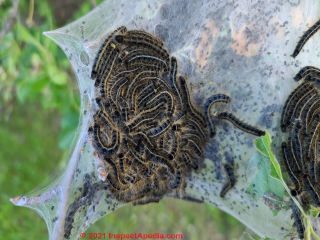
- skin redness
- sleep disorders
Meet the Q&A on "Sleep Aloofness" establish at MOLD RELATED Disease FAQs-2
- slurred spoken language or exact dysfunction (trouble in speaking)
- sneezing fits
- spitting up or vomiting mucous
- Sporotrichosis
Summary: Sporotrichosis, which is acquired past the dimorphic fungus Sporothrix schenckii, is currently distributed throughout the world, especially in tropical and subtropical zones. Infection mostly occurs past traumatic inoculation of soil, plants, and organic matter contaminated with the fungus. Certain leisure and occupational activities, such every bit floriculture, agriculture, mining, and woods exploitation, are traditionally associated with the mycosis.
Zoonotic transmission has been described in isolated cases or in minor outbreaks. Since the cease of the 1990s there has been an epidemic of sporotrichosis associated with transmission past cats in Rio de Janeiro, Brazil. More than than 2,000 human cases and 3,000 beast cases have been reported. In humans, the lesions are unremarkably restricted to the skin, subcutaneous cellular tissue, and adjacent lymphatic vessels.
In cats, the affliction tin can evolve with astringent clinical manifestations and frequent systemic interest.
The gold standard for sporotrichosis diagnosis is culture. However, serological, histopathological, and molecular approaches have been recently adopted as auxiliary tools for the diagnosis of this mycotic infection. The first-choice handling for both humans and cats is itraconazole. -
Source: de Lima Barros, Mônica Bastos, Rodrigo de Almeida Paes, and Armando Oliveira Schubach. "Sporothrix schenckii and Sporotrichosis." Clinical microbiology reviews 24, no. 4 (2011): 633-654.
- bloated glands
- swollen lymph nodes
- Syndromes, mold-related
- Chromoblastomycosis
- Eye Infections
- Lobomycosis
- Mycetoma
- Smash, Hair, and Skin affliction
- Onychomycosis (Tinea unguium)
- Piedra
- Pityriasis versicolor
- Tinea
- Tinea barbae
- Tinea capitis
- Tinea corporis
- Tinea cruris
- Tinea favosa
- Tinea nigra
- Tinea pedi
- Otomycosis
- Phaeohyphomycosis
- Rhinosporidiosis
- Systemic candida infection - meet Candida
T
- Pharynx irritation
- Tightness in the chest (this tin exist a common symptom of many complaints including mold-triggered asthma attacks)
- Tinea (Ringworm) almost common fungal disease is this superficial mycosis, not linked to IAQ/edifice-related illness. Highly contaigous.
Ringworm is a common skin infection that is caused by a fungus. It's called "ringworm" because it tin cause a round rash (shaped like a ring) that is unremarkably red and itchy.
Anyone can become ringworm. The fungi that crusade this infection can live on skin, surfaces, and on household items such as wearable, towels, and bedding. Ringworm goes past many names. The medical terms are "tinea" or "dermatophytosis."
Other names for ringworm are based on its location on the body — for example, ringworm on the anxiety is besides called "athlete's foot.
- NIH, About Ringworm, retrieved 2017/10/16 original source: https://www.ncbi.nlm.nih.gov/pubmedhealth/PMHT0024876/Also run across this ringworm data at the US CDC - https://www.cdc.gov/fungal/diseases/ringworm/alphabetize.html
Tinea versicolor, also referred to as pityriasis versicolor, is a skin condition characterized by minor patches of lighter or darker pare. It is acquired by a type of mucus that is establish on almost everyone'southward pare. It is mostly not harmful and information technology isn't contagious.
Topical treatments, such equally special creams or shampoos, are commonly effective.
Symptoms of Tinea Versicolor
In tinea versicolor, pocket-size round or oval patches of peel appear at first, and later merge into larger patches with irregular shapes. They are specially common on the dorsum, chest, cervix and/or arms. They may occur on the face up as well, particularly in children.
The patches may be yellow or dark-brown, or sometimes red or pink. They are usually lighter or darker than the surrounding healthy pare. Considering these patches hardly change colour in the sun, they are more noticeable if y'all have a suntan. Only if yous take a fair complexion, they may turn a petty brown. The affected areas of peel may also be somewhat scaly. They rarely itch. If they do, then they only itch a little.
- NIH Tinea versicolor, retrieved 2017/10/16, original source: https://www.ncbi.nlm.nih.gov/pubmedhealth/PMH0076676/ - Tremors (shaking)
Trichothecene mycotoxin poisoning symptoms & medical enquiry
- Trichothecene poisoning (Alternate names: Mycotoxins, T2, Yellow rain) - possibly related to mycotoxin exposure from some molds.
The US CDC offers lab criteria for diagnosis of Trichothecend poisoning including:- Biologic: Selected commercial laboratories are offer immunoassays to identify trichothecenes or trichothecene-specific antibodies in human being blood or urine (two, 3). Still, these procedures have not been analytically validated and are not recommended.
- Environmental: Detection of trichothecene mycotoxins in environmental samples, as adamant by FDA.
- References for poisoning by mycotoxins, T2, Yellowish Rain, or Trichothecenes:
Clinical Guide to Bioweapons and Chemical Agents, Vincent Due east. Friedewald, Springer, London, ISBN 978-1-84628-787-9 (online),
Trichothecene poisoning is discussed in depth at the US CDC website where the following references are besides provided: - Wannemacher RW Jr, Wiener SL. Trichothecene mycotoxins. In: Zajtchuk R, Bellamy RF, eds. Textbook of military machine medicine: medical aspects of chemical and biologic warfare. Washington, DC: Office of the Surgeon General at TMM Publications, Borden Institute, Walter Reed Ground forces Medical Center; 1997:655-77.
- Croft WA, Jastromski BM, Croft AL, Peters HA. Clinical confirmation of trichothecene mycotoxicosis in patient urine. J Environ Biol 2002;23:301-20.
- Vojdani A, Thrasher Hd, Madison RA, Gray MR, Heuser Thousand, Campbell AW. Antibodies to molds and satratoxin in individuals exposed in water-damaged buildings. Arch Environ Health. 2003;58:421-32.
- Tuomi T, Reijula K, Johnsson T, et al. Mycotoxins in rough edifice materials from water-damaged buildings. Appl Environ Microbiol 2000;66:1899-904.
- US CDC: "Case Definition: Trichothecene Mycotoxin", http://www.bt.cdc.gov/agent/trichothecene/casedef.asp 3/30/09 discusses the possibility of making weapons from Trichothecene mycotoxins.
Reader follow-up:
2016/xi/12, Anna levis said:
The trichothecene mycotoxins produced by toxic blackness mold are neurotoxic. This ways they tin can kill neurons in the brain and impair a person'due south mental ability. They also cause nervous disorders such as tremors and tin can cause personality changes such as mood swings and irritability.
Symptoms of trichothecene mycotoxin poisoning:
- Assailment and other personality changes - we have observed this commencement-hand and also phone call readers' attention to sheep circling disease - Ed.
- Feet
- Encephalon fog
- Confusion
- Low
- Difficulty concentrating and paying attention
- Disorientation
- Dizziness
- Hallucinations
- Impaired learning ability
- Memory loss and memory problems
- Numbness
- Seizure
- Shaking
- Shock
- Shortened attention span
- Slowed reflexes
- Tingling
- Trembling
This comment was posted originally at MOLD CLEANUP - Forest FRAMING & PLYWOOD
Thanks, Anna,
The phrase "black mold" is very misleading.
- Beginning, not all "blackness molds" are toxic and that there are plenty of molds of other colors that are equally risky or wellness-hazards for people. Meet Black COSMETIC MOLD - non all black mold is harmful
- Second, of the millions+ genera/species of molds plant on earth, or even just the few hundred commonly-found in buildings, in that location are many mold genera/species that are not black, may exist light colored, even white or lite green or gray and that as harmful or even a greater wellness chance that the nigh-popular "toxic black mold" of Stachybotrys chartarum.
For instance the very minor and often pathogenic Aspergillus or Penicillium mold spores are very common in buildings and probably crusade far more illnesses than South. chartarum. We written report and we blame what'southward piece of cake to see, non necessarily what's present and virtually harmful.
S. chartarum is a insufficiently big sticky spore that is not easily airborne, as much as 25 times larger than an Aspergillus or Penicillium mold spore. Aspergillus or Penicillium mold spores are easily airborne and can remain in the air for many hours, moving in a building more or less as would a gas riding on air currents.
- Tertiary, Picket out: the symptoms you listed... that you quoted from a website, are absolutely not restricted to trichothecene mycotoxin poisoning and could exist caused past any of a large number of conditions, hazardous exposures, or by other health bug. People suffering from the symptoms yous listed should consult with their doctor promptly and in farthermost cases should seek immediate emergency medical care.
Research on trichothecene mycotoxin poisoning
- MOLD ATLAS & PARTICLES INDEX - Index & photo-guide to indoor mold, pathogens, allergens, particles . Medical Health Effects of Mold, House Dust. Health Effects of Fiberglass, Creature Dander, Insect Fragments, Etc. Photographs of edifice mold are in this document
- Rocha, O., Thousand. Ansari, and F. M. Doohan. "Furnishings of trichothecene mycotoxins on eukaryotic cells: a review." Nutrient additives and contaminants 22, no. four (2005): 369-378.
- Sorenson, W. G., DAVID G. Frazer, BRUCE B. Jarvis, J. A. Due north. Due east. T. Simpson, and V. A. Robinson. "Trichothecene mycotoxins in aerosolized conidia of Stachybotrys atra." Applied and Environmental Microbiology 53, no. 6 (1987): 1370-1375.
- Ueno, Y., N. Sato, K. Ishii, K. Sakai, H. Tsunoda, and M. Enomoto. "Biological and chemical detection of trichothecene mycotoxins of Fusarium species." Practical microbiology 25, no. four (1973): 699.
- Krska, R., S. Baumgartner, and R. Josephs. "The state-of-the-fine art in the analysis of type-A and-B trichothecene mycotoxins in cereals." Fresenius' journal of analytical chemistry 371, no. three (2001): 285-299.
- Yang, Gi-Hyeok, Bruce B. Jarvis, Yong-Joo Chung, and James J. Pestka. "Apoptosis induction by the satratoxins and other trichothecene mycotoxins: relationship to ERK, p38 MAPK, and SAPK/JNK activation." Toxicology and practical pharmacology 164, no. ii (2000): 149-160.
- Smoragiewicz, Wanda, Bruno Cossette, Armel Boutard, and Krzysztof Krzystyniak. "Trichothecene mycotoxins in the dust of ventilation systems in role buildings." International athenaeum of occupational and environmental wellness 65, no. 2 (1993): 113-117.
- Wannemacher, Robert W., STANLEY L. Wiener, Frederick R. Sidell, Ernest T. Takafuji, and David R. Franz. "Trichothecene mycotoxins." Medical aspects of chemic and biological warfare (1997): 655-676.
U
- unexplained fevers
- Upper respiratory symptoms (eg, nasal congestion, sinus headache, episodic dyspnea)
- urinary tract infection (UTI)
V
- Vaginal yeast infections - wee Women' health problems (below)
- vertigo or dizziness
- VOC sensitivity:
- volatile organic chemicals may reach levels sufficient to produce central nervous organisation symptoms such equally headache, disability to concentrate, or dizziness
- vomiting (nausea)
WXYZ
- Weakness, loss of strength
- wheezing breath
- women's wellness issues, nonspecific
- yeast infections, vaginal, (other?) symptoms: Vaginal. Recurrent episodes of Candida vaginitis associated with the classic symptoms of pruritus, burning and abnormal discharge.
- Gastrointestinal. Heartburn, bloating, diarrhea or constipation.
- Respiratory allergy. Rhinitis, sneezing and/or wheezing.
- Fundamental nervous arrangement. Feet, low, retentivity deficits and/or loss of ability to
concentrate. - Menstrual abnormalities. Astringent premenstrual tension and/or menstrual irregularities.
Other Systemic Symptoms. - Fatigue, headache and/or irritability.
- Zygomycosis , mucormycosis or phycomycosis or hyphomycosis
Zygomycosis, as well known equally mucormycosis or phycomycosis or hyphomycosis, is a rapidly-progressive life-threatening deep fungal infection primarily affecting patients with decreased immunity.
Rare compared to other infectious pathologies, information technology is gaining more ground recently. Mucormycosis has predilection for certain groups of people, including immune-suppressed and diabetic patients.
This aggressive infection comes in a variety of forms. Despite recent advances in its medical and surgical treatments, it still retains a poor prognosis with high morbidity and bloodshed.
...Mucormycosis is a broad term for a multitude of diseases caused by infection with different fungi in the order of Mucorales. The most common causative organisms are from the Rhizopus species.
Other species include, in descending club, include Rhizomucor, Cunninghamella, Apophysomyces, Saksenaea, Absidia, Mucor, Syncephalastrum, Cokeromyces, and Mortierella.[1] These fungi are ubiquitous in nature and have earth-wide distribution. Mucor is a rapidly growing fungus that is ordinarily dark gray or low-cal olive gray when grown on typical laboratory media.
It is hands recognizable microscopically past its tall needle like sporangiophores and large sporangium. The mold grows and spreads chop-chop. Like other members of the course Zygomycetes, Mucor fungi can reproduce asexually with spores, or sexually by fusing to create zygospores which contain a mixture of genetic material. Mucor can exist nowadays in the outdoor or indoor settings. In the outdoors, it tin can be found in soil, decaying vegetation, hay, stored seeds or horse manure. Indoors, it can be found in house dust, and poorly maintained vacuum systems or dirty carpets.
One study looking at the nigh frequent molds found in house dust constitute Mucor in 98% of the samples from homes in Denmark and 31% of the samples in homes in Canada.[2] Heavy inhalation of the Mucor spores can crusade extrinsic allergic alveolitis and ultimately pulmonary fibrosis if the fungus exposure persists.
The supreme danger of Mucor, still, lays in the fact that it can become an opportunistic pathogen causing deep fungal infection when conditions are right. Ripe conditions for aggressive zygomycosis include significantly compromised immunity such in malignancy, neutropenia, use of immunosuppressive agents, metabolic acidosis, uncontrolled diabetes, starvation, severe trauma or other forms of debilitation. Information technology is well documented that they can cause a multitude of pathologies not only in humans but too in cattle, sheep, swine and dogs.[3]
In Australia, mucormycosis was documented to cause severe pare lesions in frogs[iv] and the Tasmanian platypus.[5] The histopathologic hallmark of this infection is the mycotic invasion of the blood vessels, oft leading to thrombosis, followed by tissue infarction and necrosis mediated by fungal proteases, lipases and mycotoxins.[vi] This aggressive vasculature invasion can not only affect the small vessels such as arterioles but can too reach large arteries causing devastating results such as rupture of the aorta.[7]
- The Ascent of an Oppurtunistic Infection called "Invasive Zygomycosis" Abdelkarim Waness, Ghuzayel Al Dawsari, and Hamdan Al Jahdali at US NIH https://www.ncbi.nlm.nih.gov/pmc/articles/PMC2840956/
Watch Out: this MOLD RELATED Disease SYMPTOMS list is a complaint list, not a medical document. It has not been peer-reviewed past the medical profession, and this list is not in any medical sense authoritative, nor tin any list of mold illness complaints or symptms exist consummate. Readers tin non rely on this document for medical diagnosis and instead should consult with their physician or with a specialist such as a medical toxicologist.
Reader Comments & Q&A
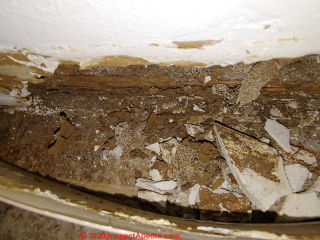 Not certain, Micah, but conspicuously at that place's h2o damage and falling plaster; I meet what looks like rusty debris from metal or wood - the photo lacks context.
Not certain, Micah, but conspicuously at that place's h2o damage and falling plaster; I meet what looks like rusty debris from metal or wood - the photo lacks context.
What am I looking at? It's within the walls of my bathroom
Gina
You should take these questions to your doctor, someone who tin can examine and interview you in detail and with the proper expertise. On internet at that place are merely too many opinions without diagnosis.
It'southward reasonable so, to ask your md about the plausible causes of your complaints and symptoms, including of form contaminants in the indoor environment.
My boyfriend and I have been living in an apartment that had a huge leak from the kitchen that extended to the living room carpet north thru bath wall. We are now seeing black discoloration under our pare, black ooze from our pare along with other bug.
Nosotros know mold us in our apt as it's in every window seal northward overtaking one bedroom which we exercise not utilise. Of course other symptoms with dizziness n chills etc merely is the discoloration probably due to over exposure of mold spores?
Jamie
That doesn't sound similar a mold problem to me, but nobody tin diagnose illnesses by a brief eastward-text; I'd say if the trouble persists check with your doctor.
I used a sipping cup yesterday that I haven't used in most 2 months. The last time it was used was for storing prepped scrambled eggs.
I used it for my iced java this time. I was having a hard time drinking out of the sipper spout, when I got a large release, a big sliver of mucus like difficult substance came out! Always since, I have a weird dry patch in the back of my throat. Is this something to exist worried nearly?
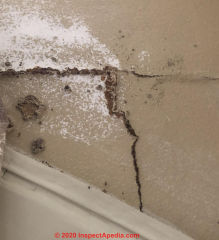 Sorry, Layla but no, not from your photograph lone can one place that the material is mold nor, if it is mold, what's the genera/species.
Sorry, Layla but no, not from your photograph lone can one place that the material is mold nor, if it is mold, what's the genera/species.
That looks to me like efflorescence and moisture leaks through a plaster wall.
The amount looks trivial - clean upwards using normal household cleaners; watch for signs of and investigate further if there are leaks into the wall.
Any idea what kind of mold?
No, Mitzi, in full general mold, that is mold spores, cannot enter your body directly through your skin unless the pare is cutting or similarly compromised.
However
- mold spores of SOME molds (not all molds are pathogenic or harmful to humans) can get into an open cut or sore on your body to possibly cause a fungal infection in that location.
- some mold spores tin can get into a sinus crenel through being inhaled through the nose to give a fungal sinus infection
- some small mold spores such as members of the Aspergillus or Penicillium mold families can be breathed into the lung and in immune-compromised people can lead to fungal infection there - such as Aspergillosis
- And finally, WHILE THE HEALTH Chance IS LOW For Nigh PEOPLE (Boonen 2012) information technology might exist possible for MYCOTOXINS in a few molds including MVOCs to be captivated through the skin
- that'due south not spores entering the body but rather chemicals produced past some molds.
See
Boonen, Jente, Svetlana V. Malysheva, Lien Taevernier, José Diana Di Mavungu, Sarah De Saeger, and Bart De Spiegeleer. "Human skin penetration of selected model mycotoxins." Toxicology 301, no. i-3 (2012): 21-32. All mycotoxins penetrated through the peel, except for FB1, which showed concentrations in the receptor fluid below the LoD, resulting in a Kp < iii.24 × ten−vi cm/h. ota showed the highest permeation (kp = 8.20 × 10−iv cm/h), followed by cit (kp = 4.67 × ten−iv cm/h). afb1 and zea showed lower permeability rates (kp = 2.11 and 2.33 × 10−four cm/h, respectively). t-2 was found to have the lowest permeability (kp = half-dozen.07 × 10−5 cm/h). from literature-based mycotoxin-concentrations, dermal contact surface, exposure time and apparent kp's obtained in this study, the daily dermal exposure (dde) in two industrial and 1 residential scenario was estimated. dermal exposure to the deoxyribonucleic acid-reactive genotoxic carcinogenic afb1 tin can lead to a health risk for agricultural workers which are exposed to a mycotoxin contaminated solution in a worst example state of affairs. for all the other investigated mycotoxins, no pregnant health risk is calculated afterwards dermal contact in neither agronomical nor residential environments.
Abstruse:
Dermal exposure data for mycotoxins are very scarce and fragmentary, despite their widespread pare contact and hazard toxicity. In this study, the transdermal kinetics of aflatoxin B1 (AFB1), ochratoxin A (OTA), fumonisin B1 (FB1), citrinin (CIT), zearalenone (ZEA) and T-2 toxin (T-2) were quantitatively evaluated, using human skin in an in vitro Franz improvidence cell prepare-upward.
kemppainen, b. westward., r. t. riley, and j. one thousand. step. "skin assimilation as a route of exposure for aflatoxin and trichothecenes." journal of toxicology: toxin reviews 7, no. 2 (1988): 95-120.
senkpiel, k., d. sassenberg, r. keller, and h. ohgke. "content of mycotoxins in conidiospores from mould in buildings." mycotoxin research sixteen, no. 1 (2000): 88-93.>
Can mold inter your trunk thru the skin?
...
Continue reading at MOLD RELATED Illness GUIDE or select a topic from the closely-related articles below, or see the complete ARTICLE Index.
Or encounter MOLD RELATED Affliction FAQs - questions & answers posted originally at this article
Or see these
Recommended Articles
- BLACK MOLD, HARMLESS - Photos of of frequently recognizable, usually harmless or corrective blackness mold on woods
- MOLD Appearance - WHAT MOLD LOOKS Like - Photos of what mold looks similar in buildings, organized by mold color and appearance.
- MOLD Advent - STUFF THAT IS NOT MOLD - Photos of material that is non mold only is sometimes mistaken for mold
- MOLD ATLAS & PARTICLES INDEX, Pathogens, Allergens and Other Indoor Particles - actual and possible medical health effects of Mold (separate online document)
- MOLD CLEANUP GUIDE- HOW TO Get RID OF MOLD
- MOLD DOCTORS - ENVIRONMENTAL MEDICINE
- MOLD EXPOSURE STANDARDS
- MOLD FREQUENCY in BUILDINGS - Table of what mold genera/species are frequently found in indoor mold tests.
- MOLD GROWTH ON SURFACES, PHOTOS - Photos of what mold looks like in buildings on more than 100 surfaces, organized past mold growth on diverse kinds of building surfaces and contents or items establish in buildings. Mold in situ.
- MOLD GROWTH on SURFACES, Table OF - Summary table of what mold genera/species are frequently found on diverse building surfaces and materials
- MOLD By MICROSCOPE - Mold nether the microscope - photo identification of the nigh common indoor molds found in buildings
- MOLD in the PETRI DISH, PHOTOS - what mold looks like on civilization plates or in civilisation-blazon mold test kits
- MOLD RELATED Illness GUIDE
- MOLD RELATED Disease SYMPTOMS
- MOLD SPORES in the Abode - a Photo ID Library for detection and identification of mold allergens on indoor building surfaces and for an atlas of building molds.
- WHO MOLD BULLETIN
Suggested commendation for this web page
MOLD RELATED ILLNESS SYMPTOMS at AuditApedia.com - online encyclopedia of building & environmental inspection, testing, diagnosis, repair, & problem prevention advice.
Or see this
Index to RELATED ARTICLES: ARTICLE Index to MOLD CONTAMINATION & REMEDIATION
Or utilise the SEARCH BOX plant beneath to Ask a Question or Search InspectApedia
...
Ask a Question or Search InspectApedia
Questions & answers or comments about possible symptoms of mold related illness & wellness complaints.
Endeavour the search box just beneath, or if yous adopt, postal service a question or comment in the Comments box beneath and we will respond promptly.
Search the InspectApedia website
Note: appearance of your Annotate below may exist delayed: if your comment contains an image, web link, or text that looks to the software as if it might exist a web link, your posting volition appear after it has been approved past a moderator. Apologies for the filibuster.
Technical Reviewers & References
Click to Show or Hide Citations & References
Publisher InspectApedia.com - Daniel Friedman
Source: https://inspectapedia.com/mold/Mold_Illness_Symptoms.php
0 Response to "Can Mold Spores Cause Chronic Migraines for Years"
Post a Comment